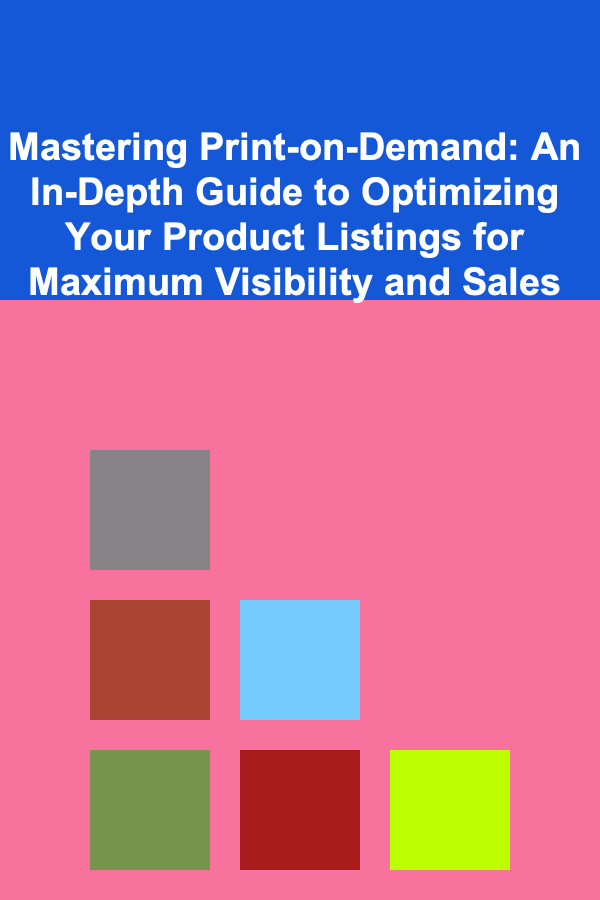
Mastering Print-on-Demand: An In-Depth Guide to Optimizing Your Product Listings for Maximum Visibility and Sales
ebook include PDF & Audio bundle (Micro Guide)
$12.99$8.99
Limited Time Offer! Order within the next:

In the burgeoning world of Print-on-Demand (POD), the ease of creating and selling custom products has democratized entrepreneurship. However, this very accessibility has also created an intensely competitive landscape. For your unique designs to truly stand out and convert into sales, merely uploading them isn't enough. The secret to success lies in meticulously optimizing every facet of your product listings. This comprehensive guide delves into the multi-layered strategies essential for transforming a dormant product listing into a powerful sales magnet, covering everything from the psychological underpinnings of consumer behavior to the intricate technicalities of search engine optimization.
The Foundational Pillars: Before Optimization Begins
Before diving into the specifics of listing optimization, it's crucial to establish a robust foundation. Your optimization efforts will yield minimal results if the underlying product or market understanding is flawed.
Understanding Your Niche and Target Audience
Every successful POD business is built on a clear understanding of its target market. Who are you selling to? What are their interests, pain points, and desires? What cultural references or inside jokes resonate with them? Defining your niche isn't just about selecting a broad category like "T-shirts"; it's about identifying a specific demographic, a subculture, or a particular passion point. For instance, instead of "animal lovers," consider "cat lovers," or even more specifically, "introverted cat lovers who appreciate minimalist design."
- Demographics: Age, gender, location, income level, occupation.
- Psychographics: Interests, hobbies, values, lifestyle, personality traits.
- Behavioral Data: Past purchase behavior, online activity, preferred shopping platforms.
This deep understanding informs not only your designs but also your keyword strategy, the tone of your descriptions, and the visual aesthetics of your images. Without this clarity, your optimization efforts will be like shouting into a void -- you might be loud, but no one is listening.
The Inherent Quality of Your Product and Design
No amount of optimization can compensate for a poor-quality product or an unappealing design. Your designs must be:
- Original and Appealing: Differentiate yourself. Trends are good, but unique interpretations are better. Ensure your artwork is high-resolution and suitable for the chosen product type.
- Relevant to Your Niche: Does the design genuinely resonate with your identified target audience?
- Technically Sound: Ensure proper file formats, resolution, and transparency for printing. A fuzzy or pixelated design on a real product is a death knell.
Similarly, the quality of the blank product (e.g., the t-shirt, mug, or hoodie) matters. Choose reputable POD providers known for their product quality, consistent printing, and reliable fulfillment. A scratchy t-shirt or a faded print will lead to negative reviews, regardless of how perfectly optimized your listing is.
The Core Pillars of Listing Optimization
With a solid foundation in place, we can now delve into the specific elements of a product listing that demand meticulous optimization.
1. Keyword Research & SEO: The Unseen Architect of Discovery
Search Engine Optimization (SEO) for POD listings is fundamentally about connecting your product with potential buyers actively searching for it. It's the engine that drives visibility.
The Importance of Keywords
Keywords are the terms and phrases people type into search bars to find products. Effective keyword research reveals not just what people are searching for, but how they are searching for it, their intent, and the level of competition. For POD, this applies equally to internal platform search engines (Etsy, Amazon, Redbubble, etc.) and external search engines like Google.
Types of Keywords to Target:
- Short-Tail Keywords: Broad terms (e.g., "graphic tee"). High search volume, but also high competition and less specific buyer intent.
- Mid-Tail Keywords: More specific (e.g., "funny cat t-shirt"). Moderate volume and competition, better intent.
- Long-Tail Keywords: Very specific phrases (e.g., "vintage funny cat playing guitar t-shirt for men"). Lower search volume individually, but collectively represent a significant portion of searches. Crucially, they indicate strong buyer intent and often have lower competition, leading to higher conversion rates.
- Latent Semantic Indexing (LSI) Keywords: Synonyms and related terms that help search engines understand the context of your listing (e.g., for "coffee lover mug," LSI might include "espresso cup," "caffeine addict gift," "morning brew").
Practical Keyword Research Techniques:
- Brainstorming: Start with your product and niche. What would you search for? Think about different angles:
- Product Type: T-shirt, hoodie, mug, phone case, tote bag.
- Design Theme: Cats, dogs, space, nature, humor, politics, vintage, minimalist.
- Target Audience: Mom, dad, gamer, nurse, teacher, vegan, introverted.
- Occasion/Holiday: Christmas, Halloween, Birthday, Mother's Day, Valentine's Day.
- Style/Aesthetic: Grunge, aesthetic, cottagecore, retro, sarcastic, wholesome.
- Problem/Solution: "Gift for programmer," "unique pet owner gift."
- Platform Search Bar Suggestions: As you type into the search bar on Etsy, Amazon, Redbubble, etc., notice the auto-complete suggestions. These are real searches by real people.
- Competitor Analysis: Look at top-selling listings in your niche. What keywords are they using in their titles, descriptions, and tags? Don't copy, but learn from their successful strategies.
- Keyword Tools:
- Free Tools: Google Keyword Planner (requires Google Ads account), Ubersuggest, AnswerThePublic, Google Trends.
- Paid Tools: Ahrefs, Semrush, Keyword Tool.io, various Etsy/Amazon specific tools (e.g., eRank, Marmalead for Etsy, Helium 10 for Amazon).
- Review Mining: Read customer reviews on competitor products or similar items. What language do customers use to describe what they liked or disliked? This can reveal valuable long-tail keywords and pain points.
Where to Place Keywords:
Strategic keyword placement is crucial for both search engine algorithms and human readability.
- Product Title (Most Important): Front-load your most important, high-intent keywords here. Make it descriptive but not stuffed.
- Example: Instead of "Cool Cat Shirt," use "Funny Introvert Cat T-Shirt | Sarcastic Feline Lover Tee | Retro Animal Gift for Women Men."
- Product Tags/Keywords (Platform Specific): Utilize all available tag slots. Use a mix of short, mid, and long-tail keywords. Experiment with synonyms and variations.
- Product Description: Naturally weave keywords into your description. Don't keyword stuff; prioritize readability and providing value to the customer. Use LSI keywords here.
- Image Alt Text (where available): Describe your image using keywords. This helps search engines understand what the image is about.
Key Takeaway: Keyword research is not a one-time task. Trends change, and search behavior evolves. Regularly revisit and refine your keyword strategy. Focus on buyer intent and long-tail phrases for higher conversion potential.
2. Crafting Compelling Product Titles: Your Digital Billboard
Your product title is often the first, and sometimes only, element a potential customer sees in search results. It must be a powerful blend of informativeness and allure.
Principles of an Effective Title:
- Front-Load Keywords: Place your primary keywords at the beginning of the title. This is where search engines and human eyes first focus.
- Clarity and Specificity: Clearly state what the product is. "Funny Cat T-Shirt" is better than "Cat Design."
- Include Key Attributes: Mention relevant details like gender (men's, women's, unisex), style (vintage, minimalist), material (soft cotton), or special features.
- Highlight Benefits/Occasions: Connect the product to a specific use case or benefit. "Perfect Gift for Cat Lovers," "Birthday Present for Introverts."
- Adhere to Character Limits: Each platform has different limits. Optimize within those constraints. Remember that titles can be truncated in search results, so the most vital information should be upfront.
- Readability: Use pipes (|), dashes (-), or commas (,) to separate distinct keyword phrases and improve readability. Avoid excessive capitalization or emojis unless specifically suited to your brand/niche.
- Brand/Niche Integration: If your brand has a recognizable identity or your niche is very specific, integrate it naturally.
Bad Example: "Shirt with Cat"
Better Example: "Funny Cat Lover T-Shirt"
Optimized Example: "Funny Introvert Cat T-Shirt | Sarcastic Feline Lover Tee | Retro Animal Gift for Men & Women"
3. Writing Engaging Product Descriptions: Telling Your Product's Story
While images attract, the description converts. It's your opportunity to provide comprehensive information, build trust, and persuade the buyer that your product is exactly what they need.
Structure of a Powerful Description:
- The Hook (First Paragraph):
- Immediately capture attention and reiterate the core appeal.
- Connect with the buyer's emotion or desire. "Are you a proud cat parent who secretly loves staying home?"
- Naturally integrate your primary keyword.
- Highlight Benefits, Not Just Features:
- Features: What the product is (e.g., "100% cotton," "Direct-to-Garment printing").
- Benefits: What the product does for the customer (e.g., "Soft and breathable for all-day comfort," "Vibrant print that won't crack or fade after washing").
- Focus on how the product solves a problem, fulfills a desire, or enhances their life.
- Detailed Product Specifications:
- Materials: Fabric composition (e.g., "100% Airlume combed and ring-spun cotton for a premium feel").
- Sizing: Provide clear sizing charts or instructions. Mention if sizing runs true to size, small, or large. Emphasize checking measurements.
- Care Instructions: How to wash, dry, and care for the item to ensure longevity. This manages expectations and prevents issues.
- Printing Process: Briefly explain your POD process (e.g., "Printed with eco-friendly inks using advanced DTG technology").
- Call to Action (CTA):
- Gently guide the customer on what to do next. "Add to Cart," "Shop Now," "Browse our full collection."
- Can be subtle or direct.
- Additional Information:
- Shipping and Production Times: Be transparent about typical processing and delivery estimates, especially for POD where items are made to order.
- Return/Exchange Policy: Briefly mention or link to your shop policies.
- Customization Options: If applicable, explain how to request customizations.
Optimization Tips for Descriptions:
- Readability is Key: Use short paragraphs, bullet points, and bold text to break up long blocks of text. No one wants to read a wall of text.
- Natural Keyword Integration: Weave your secondary and LSI keywords naturally throughout the description. Avoid "keyword stuffing" -- it hurts readability and can be penalized by algorithms.
- Storytelling: Can you tell a brief story about who this product is for or the inspiration behind the design? This creates an emotional connection.
- Tone of Voice: Match your description's tone to your brand and niche (e.g., witty, serious, heartfelt, quirky).
- Proofread: Errors undermine credibility. Always proofread for typos and grammatical mistakes.
4. High-Quality Product Images & Videos: Your Visual Sales Pitch
In the highly visual world of online shopping, images are paramount. They are often the first, and most powerful, determinant of whether a customer clicks on your listing.
The Power of Visuals:
- First Impressions: High-quality, appealing images instantly convey professionalism and quality.
- Conveying Value: They show the product's true appearance, texture, and fit.
- Emotional Connection: Lifestyle images can evoke feelings and help customers visualize themselves using the product.
- Reducing Returns: Accurate visuals reduce misunderstandings about size, color, or fit.
Types of Images You Need:
- High-Quality Mockups:
- Use realistic mockups that showcase your design on the actual product. Avoid low-resolution, generic mockups.
- Vary angles: front, back, side, close-up of design.
- Consider different product colors if applicable.
- Lifestyle Images:
- Show the product in context, being worn by diverse models in real-life settings (e.g., someone wearing a t-shirt at a coffee shop, a mug on a desk).
- These help customers visualize themselves using the product and connect emotionally.
- Ensure models represent your target audience.
- Detail Shots:
- Close-ups of the print quality, fabric texture, stitching, or unique features.
- Helps convey the quality and craftsmanship.
- Sizing Charts/Guides:
- Crucial for apparel. Provide a clear, easy-to-read sizing chart with measurements (in inches and cm).
- Show how to measure (e.g., flat lay measurements).
- Mention if the garment is unisex, fitted, or relaxed.
- Color Palettes/Options: If your product comes in multiple colors, show them clearly.
- Branding Image (Optional): An image that subtly incorporates your brand logo or aesthetic.
- Infographics: Can be used to highlight key benefits, care instructions, or product features in a visually appealing way.
Best Practices for Images:
- High Resolution: Crisp, clear images. Blurry images are unprofessional.
- Good Lighting: Natural, even lighting is best. Avoid harsh shadows or overexposure.
- Consistent Aesthetic: Maintain a consistent look and feel across all your product images for a cohesive brand identity.
- Optimize File Size: Compress images without sacrificing quality to ensure fast loading times. Large files can deter mobile users.
- Utilize All Image Slots: Most platforms allow multiple images. Use them all to showcase every aspect of your product.
- Video Content: Short, engaging videos (e.g., a 360-degree view, someone wearing the apparel and moving, or a quick unboxing) significantly boost engagement and conversion rates on platforms that support them.
5. Strategic Tagging: Enhancing Discoverability
Tags are specific keywords or phrases that categorize your product and help search engines (both internal and external) match your listing to relevant searches. They are different from keywords in your title or description in that they are often dedicated fields on the platform itself.
Maximizing Your Tags:
- Utilize All Available Tags: Don't leave any tag slots empty. Each one is an opportunity for discovery.
- Mix & Match Keyword Types: Include a blend of short-tail, mid-tail, and long-tail keywords.
- Think Like a Customer: What different ways might someone search for your product? Consider synonyms, misspellings (if common), and related concepts.
- Be Specific: Instead of just "gift," use "gift for cat lover," "birthday gift for friend."
- Platform Specifics: Understand how each platform uses tags. Etsy's tags work differently from Redbubble's, for example.
- Etsy: Each tag can be a multi-word phrase. Maximize characters per tag.
- Redbubble/TeePublic: Often favor a broader array of single-word or short phrase tags.
- Avoid Keyword Stuffing: While tags are for keywords, avoid irrelevant or excessive repetition. Stick to genuinely descriptive terms.
- Analyze and Adapt: Monitor which tags drive traffic to your listings. Remove underperforming ones and test new ones based on market trends or new keyword research.
6. Competitive Pricing Strategy: Finding the Sweet Spot
Pricing is a delicate balance between profitability, perceived value, and competitiveness. Price too high, and you deter buyers; price too low, and you devalue your brand and erode profits.
Factors to Consider:
- Cost of Goods Sold (COGS):
- Base cost of the product from your POD provider.
- Shipping costs (if passed on to the buyer).
- Platform fees (listing fees, transaction fees, payment processing fees).
- Marketing costs (if using paid ads).
- Competitor Analysis:
- Research prices of similar products from direct competitors on your chosen platform.
- Identify their pricing tiers, promotions, and perceived value.
- Value Proposition:
- What makes your product unique? Is your design superior? Is your niche underserved?
- Premium designs or highly specific niche products can often command higher prices.
- Target Audience's Budget:
- Are you targeting budget-conscious buyers or those willing to pay more for quality/uniqueness?
- Psychological Pricing:
- Prices ending in .99 (e.g., $19.99) can make an item seem cheaper than a round number ($20.00).
- Tiered pricing (e.g., different prices for different product types or sizes).
- Promotions and Sales:
- Factor in the ability to run sales or offer discounts without going below your profit margin.
- Sales can create urgency and boost conversions.
Start with a competitive price, but be prepared to adjust based on performance. Sometimes a slightly higher price can increase perceived value and attract buyers looking for quality over the lowest price.
7. Leveraging Customer Reviews & Social Proof: Building Trust
In the absence of physical interaction, online buyers rely heavily on social proof. Customer reviews are arguably the most powerful form of social proof.
The Impact of Reviews:
- Builds Trust and Credibility: Authentic reviews from real buyers alleviate doubts and foster confidence.
- Increases Conversion Rates: Products with more positive reviews consistently outperform those without.
- Provides Valuable Feedback: Reviews offer insights into what customers love (or dislike) about your product, helping you improve.
- SEO Benefits: Reviews often contain user-generated content and keywords, which can passively improve your listing's search ranking.
Strategies for Earning and Managing Reviews:
- Encourage Reviews:
- Provide an Excellent Product: The best way to get good reviews is to consistently deliver high-quality products and designs.
- Exceptional Customer Service: Prompt, friendly, and helpful responses to inquiries or issues can turn a potentially negative experience into a positive review.
- Follow-Up: Some platforms allow automated or manual follow-up messages after delivery to gently prompt for a review. Be careful not to be pushy.
- Package Inserts: A small, branded card in the package thanking them and gently asking for a review (without directly asking for a 5-star review).
- Respond to All Reviews:
- Positive Reviews: Thank the customer genuinely. This shows you appreciate their business and strengthens loyalty.
- Negative Reviews: Address them professionally and empathetically. Acknowledge the issue, apologize if necessary, and offer a solution. This demonstrates commitment to customer satisfaction and can mitigate the damage of a negative review for future buyers. Never get defensive or argue.
- Showcase Reviews: On your own website or social media, highlight positive reviews and testimonials.
Key Takeaway: Think of each review as a micro-advertisement. Encourage them, manage them, and learn from them. They are invaluable for long-term success.
Beyond the Listing: External Optimization & Promotion
While on-listing optimization is critical, driving external traffic and building brand awareness can significantly amplify your sales.
Social Media Marketing
Showcase your designs on platforms where your target audience spends time. Use engaging visuals, relevant hashtags, and interactive content.
- Instagram/TikTok: Highly visual. Perfect for showcasing lifestyle images and short videos of your products in action. Utilize trending sounds and challenges.
- Pinterest: A powerful visual search engine. Create rich pins that link directly to your listings. Optimize pin descriptions with keywords.
- Facebook Groups: Join niche-specific groups (where allowed) to share your designs or connect with potential customers.
Paid Advertising
Platform-specific ads (Etsy Ads, Amazon PPC) or external ads (Google Ads, Facebook/Instagram Ads) can provide immediate visibility and traffic.
- Targeting: Leverage detailed targeting options to reach your precise audience.
- A/B Testing: Test different ad creatives, copy, and targeting parameters to optimize performance.
- Budgeting: Start small and scale up as you see positive ROI.
Content Marketing
Create valuable content related to your niche that subtly promotes your products.
- Blogging: Write articles about your niche, offering tips, insights, or entertainment, and link to relevant products.
- YouTube: Create videos showcasing your products, explaining their origin, or reviewing similar items.
Email Marketing
Build an email list through your website or social media. Send newsletters with new product launches, promotions, or exclusive content.
Influencer Collaborations
Partner with micro-influencers in your niche to showcase your products to their engaged audience.
Analytics, A/B Testing & Continuous Improvement: The Iterative Process
Optimization is not a one-time task; it's an ongoing, iterative process. The digital marketplace is constantly evolving, and so should your strategy.
Utilizing Analytics Data:
Most POD platforms and external tools provide analytics. Pay attention to:
- Traffic Sources: Where are your customers coming from? (Search, social media, direct, referrals).
- Keyword Performance: Which keywords are driving the most views and sales?
- Conversion Rate: What percentage of visitors turn into buyers? This is the ultimate metric for listing effectiveness.
- Bounce Rate: How many visitors leave quickly after landing on your listing? High bounce rates can indicate irrelevant traffic or unappealing listings.
- Popularity of Designs/Products: Which of your designs are resonating most with your audience?
A/B Testing (Split Testing):
This involves creating two versions (A and B) of a listing element (e.g., two different titles, main images, or description hooks) and showing them to different segments of your audience to see which performs better.
- Elements to Test: Main image, title, first line of description, pricing, call to action.
- Process: Change only one variable at a time to accurately attribute performance differences. Run tests for a statistically significant period or number of views.
- Learning: Apply the winning variations to your other listings and continue testing.
Staying Updated and Adapting:
- Algorithm Changes: Search engine and platform algorithms are constantly updated. Stay informed about major changes that could impact your visibility.
- Market Trends: Keep an eye on evolving design trends, popular culture, and consumer preferences.
- Competitor Strategies: Regularly review what successful competitors are doing with their listings and marketing.
- Customer Feedback: Actively listen to customer questions, comments, and reviews to identify areas for improvement.
Conclusion: The Path to POD Success
Optimizing your Print-on-Demand product listings is a multifaceted discipline that combines art with science. It requires a deep understanding of your customer, meticulous attention to detail in your content, and a data-driven approach to continuous improvement. By mastering keyword research, crafting compelling titles and descriptions, showcasing stunning visuals, and strategically managing pricing and reviews, you transform a mere product entry into a powerful sales machine.
Remember, the goal is not just to get seen, but to convert. Every element of your listing contributes to the overall impression and the decision-making process of your potential customer. Approach optimization as an ongoing journey, constantly learning, adapting, and refining. In doing so, you will not only unlock the full potential of your designs but also build a sustainable and thriving Print-on-Demand business.
The digital shelves are vast, but with a diligently optimized listing, your unique creations are perfectly positioned to capture the attention they deserve and turn browsers into loyal customers.

How to Build a Content Promotion Checklist for Social Media
Read More
How to Create a Budget for Home Renovations
Read More
How to Create a Cozy Reading Nook for Family Story Time
Read More
How to Use Color Coding for Recipe Categories
Read More
The Health Coach's Guide: Transforming Lives Through Wellness and Support
Read More
How to Design a Zero-Energy Building
Read MoreOther Products

How to Build a Content Promotion Checklist for Social Media
Read More
How to Create a Budget for Home Renovations
Read More
How to Create a Cozy Reading Nook for Family Story Time
Read More
How to Use Color Coding for Recipe Categories
Read More
The Health Coach's Guide: Transforming Lives Through Wellness and Support
Read More